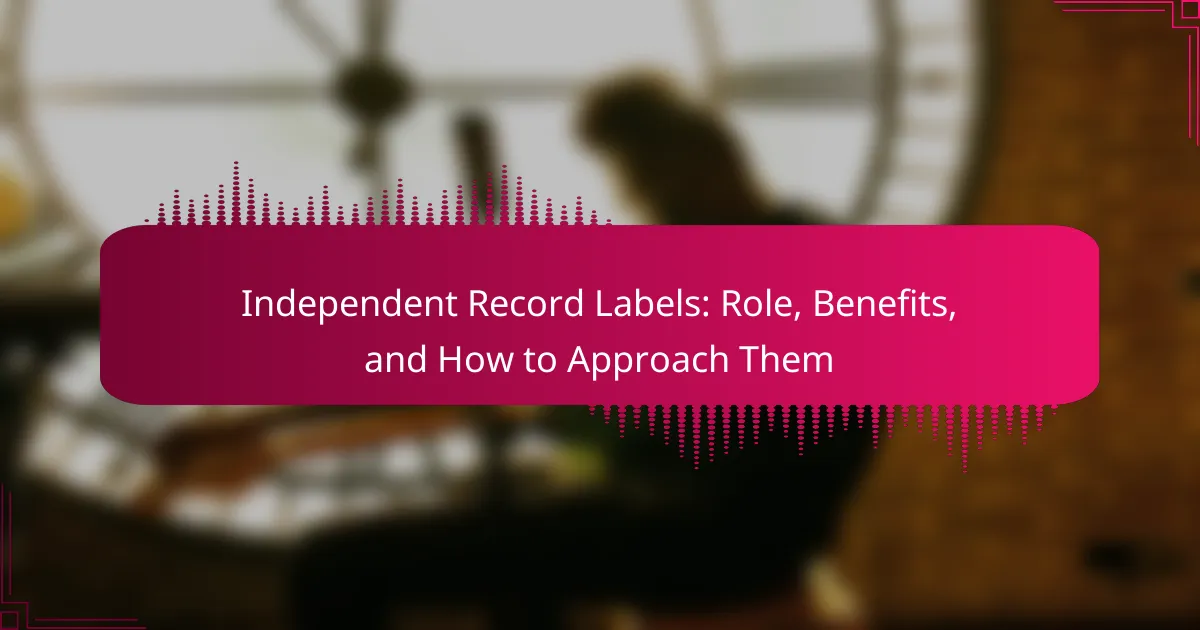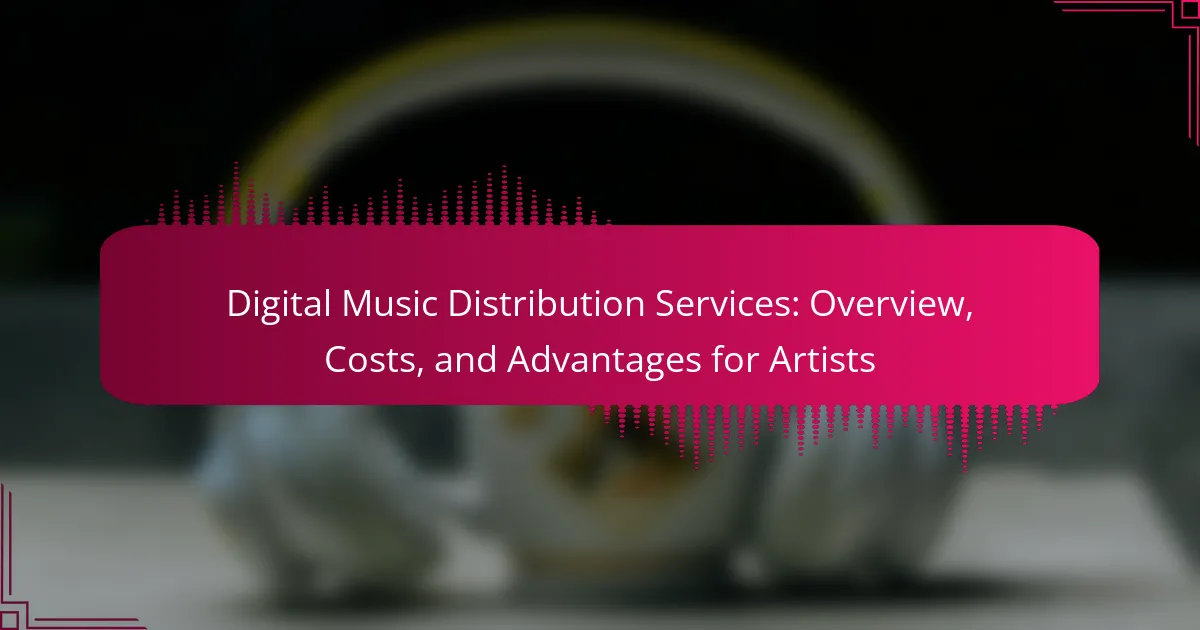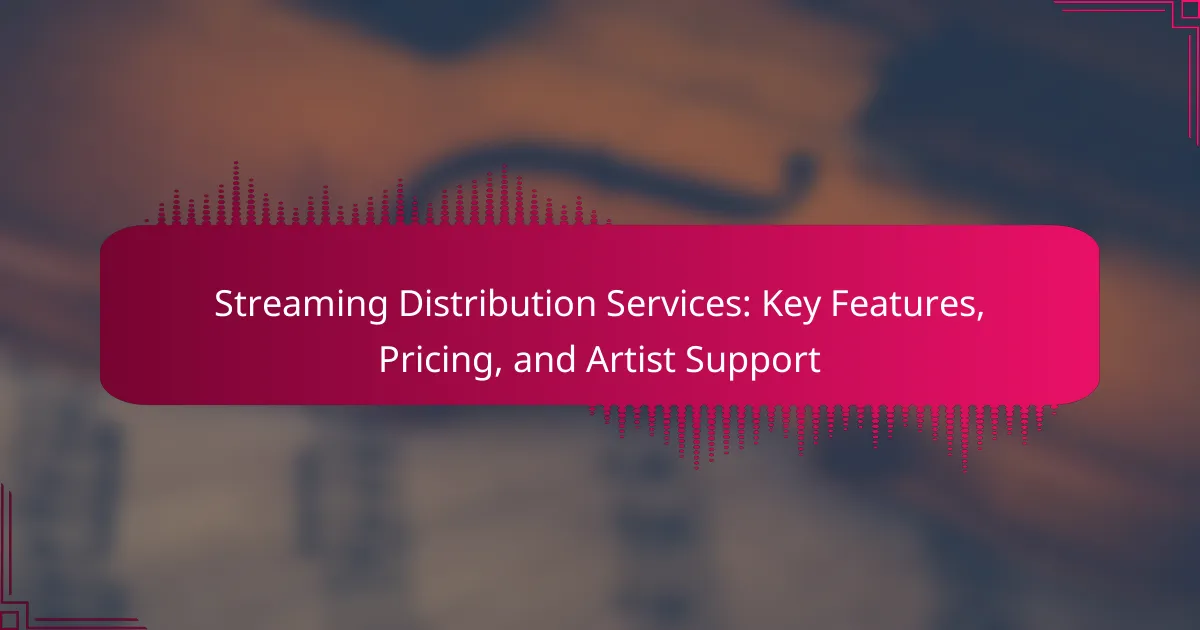Promoting independent artists effectively can be challenging due to limited resources and competition. This article explores best practices in social media engagement, local community involvement, and email marketing. It highlights success stories from artists like Chance the Rapper and Billie Eilish, showcasing innovative strategies. Additionally, it provides valuable resources such as digital marketing tools and networking events for enhanced visibility and audience connection.
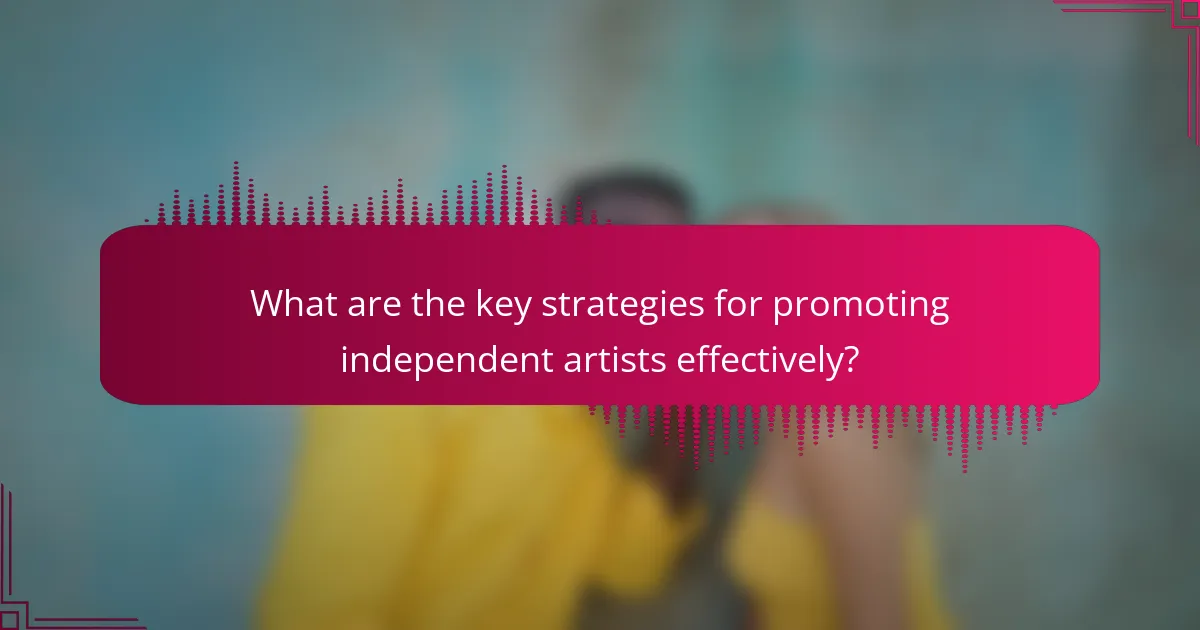
What are the key strategies for promoting independent artists effectively?
To promote independent artists effectively, leverage social media, engage with local communities, and collaborate with other artists.
Utilize platforms like Instagram and TikTok to showcase talent and build a following. Engaging with local venues and participating in community events fosters connections. Collaborations can expand reach and introduce artists to new audiences.
Additionally, consider using email marketing to maintain direct communication with fans. Share exclusive content, updates, and upcoming events to strengthen relationships.
Lastly, invest time in creating a strong brand identity. A unique visual and thematic presence helps differentiate an artist in a crowded market.
How do social media platforms influence artist visibility?
Social media platforms significantly enhance independent artist visibility by providing direct access to audiences. These platforms enable artists to showcase their work, connect with fans, and engage in real-time interactions. Successful artists utilize targeted content strategies to increase their reach. For example, platforms like Instagram and TikTok allow for visual storytelling, which can lead to viral moments that elevate an artist’s profile. Engaging with followers through live sessions and behind-the-scenes content fosters a loyal fan base, ultimately driving more visibility and opportunities.
Which promotional tools are most effective for independent artists?
Social media marketing, live performances, and collaborations are the most effective promotional tools for independent artists. Social media platforms allow artists to reach a wide audience and engage directly with fans. Live performances create memorable experiences that can enhance fan loyalty. Collaborations with other artists can introduce new audiences and expand reach. Each tool offers unique advantages that can significantly boost an artist’s visibility and success.
What role do collaborations play in artist promotion?
Collaborations significantly enhance independent artist promotion by expanding reach and audience engagement. They enable artists to tap into each other’s fan bases, creating cross-promotion opportunities. Successful collaborations often lead to increased visibility on streaming platforms and social media, driving higher engagement rates. For instance, joint projects can result in shared marketing costs and resources, maximizing promotional efforts.

How can independent artists leverage digital marketing?
Independent artists can effectively leverage digital marketing by utilizing social media, email campaigns, and content creation. These strategies enhance visibility and connect directly with audiences. Social media platforms allow for targeted engagement, while email campaigns can nurture relationships with fans. Content creation, such as blogs or videos, showcases artistic processes and builds a personal brand. Success stories from artists who adopted these methods demonstrate the potential for increased exposure and sales.
What are the best practices for email marketing in the music industry?
To excel in email marketing as an independent artist, focus on building a targeted subscriber list and crafting engaging content. Personalization enhances connection, while consistent branding reinforces identity. Utilize analytics to track performance and optimize campaigns. Collaborate with other artists for cross-promotion and leverage social media to grow your audience.
How can artists optimize their online presence for search engines?
Independent artists can optimize their online presence for search engines by focusing on quality content, keyword integration, and social media engagement. Regularly updating a professional website with relevant keywords improves visibility. Utilizing platforms like Instagram and TikTok helps reach wider audiences. Collaborating with other artists enhances credibility and backlinks, boosting search rankings. Consistent branding across all platforms reinforces identity and aids discoverability.
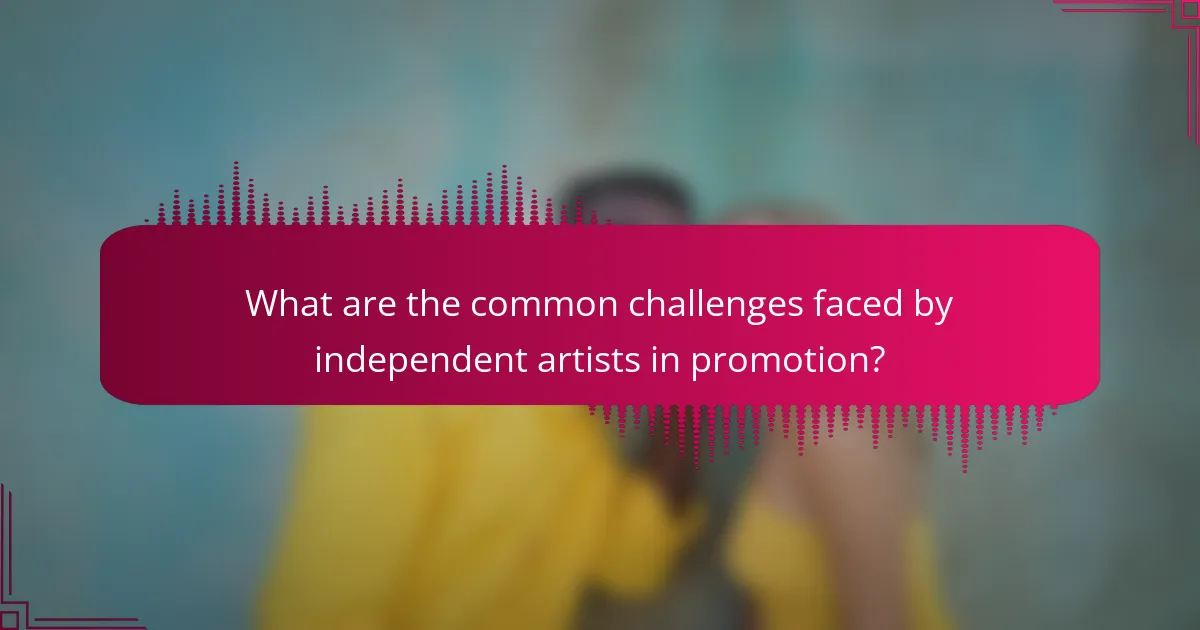
What are the common challenges faced by independent artists in promotion?
Independent artists face challenges in promotion due to limited resources, lack of industry connections, and competition with established artists. They often struggle with creating effective marketing strategies and maintaining consistent engagement with audiences. Additionally, navigating digital platforms and understanding analytics can be daunting. These factors hinder their visibility and growth in a crowded market.
How do budget constraints affect promotional efforts?
Budget constraints significantly limit promotional efforts for independent artists, impacting reach and effectiveness. Artists must prioritize cost-effective strategies to maximize visibility. Utilizing social media platforms, grassroots marketing, and collaborations can enhance exposure without substantial financial investment. Additionally, leveraging local networks and online communities fosters organic growth and engagement. By focusing on creative and resourceful methods, independent artists can navigate budget limitations and still achieve promotional success.
What are the barriers to entry for independent artists in various markets?
Independent artists face several barriers to entry in various markets, including limited access to funding, lack of industry connections, and insufficient marketing knowledge. These challenges hinder their ability to promote their work effectively. Additionally, competition from established artists and platforms can make it difficult for newcomers to gain visibility. Access to resources and support networks is often uneven, further complicating their efforts to succeed.

Which success stories exemplify effective independent artist promotion?
Successful independent artist promotion often features innovative strategies that resonate with audiences. Notable examples include Chance the Rapper, who leveraged social media and live performances to build a dedicated fan base without traditional label support. Another example is Billie Eilish, who utilized platforms like SoundCloud and TikTok to share her music, leading to viral success. Additionally, the band Twenty One Pilots effectively engaged fans through interactive social media campaigns and unique merchandise, enhancing their visibility and connection with listeners. These success stories highlight the importance of authenticity, community engagement, and digital presence in independent artist promotion.
What lessons can be learned from successful independent artists?
Successful independent artists demonstrate key lessons in promotion, including authenticity, audience engagement, and strategic collaboration. They build genuine relationships with fans, fostering loyalty and community. Utilizing social media effectively amplifies their reach and visibility. Additionally, they often collaborate with other artists, enhancing creativity and expanding their networks. Emphasizing unique branding helps them stand out in a competitive landscape.
How have specific genres adapted their promotional strategies?
Independent artists have adapted their promotional strategies by leveraging social media, utilizing digital platforms, and engaging directly with fans. These methods enhance visibility and foster community connections.
Social media platforms allow independent artists to share content instantly and interact with audiences. For example, Instagram and TikTok enable artists to showcase their music creatively, reaching wider demographics.
Digital distribution services have transformed music access. Platforms like Spotify and Bandcamp empower artists to release music independently, bypassing traditional industry gatekeepers. This democratization of music distribution increases opportunities for exposure.
Direct fan engagement strategies are crucial for building loyalty. Crowdfunding platforms like Patreon enable artists to connect with dedicated supporters, offering exclusive content and experiences. This model enhances sustainable income and fosters deeper relationships with fans.
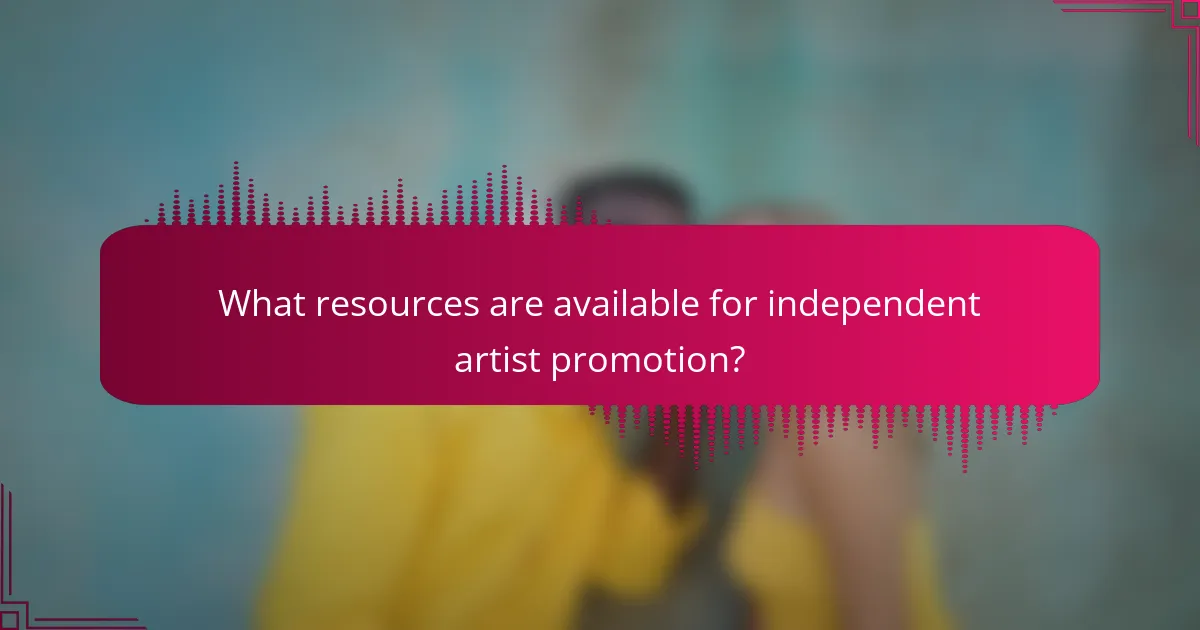
What resources are available for independent artist promotion?
Independent artists can utilize various resources for effective promotion. Key options include social media platforms, music streaming services, and industry networking events.
1. Social Media: Platforms like Instagram and TikTok allow artists to showcase their work and engage with fans directly.
2. Music Streaming: Services such as Spotify and SoundCloud provide exposure to a wider audience through playlists and algorithmic recommendations.
3. Networking Events: Conferences and local showcases enable artists to connect with industry professionals and other musicians.
4. Online Communities: Forums and groups focused on independent music offer support, collaboration opportunities, and promotional tips.
5. Digital Marketing Tools: Services like Mailchimp and Hootsuite help manage promotional campaigns and social media scheduling.
6. Crowdfunding Platforms: Websites like Kickstarter and Patreon allow artists to fund projects directly through fan support.
Which platforms offer funding or grants for independent artists?
Platforms that offer funding or grants for independent artists include Kickstarter, Patreon, and the National Endowment for the Arts. These platforms provide financial support through crowdfunding, subscription models, and government grants.
Kickstarter allows artists to launch projects and receive funds from backers. Patreon enables ongoing support through subscriptions. The National Endowment for the Arts offers grants specifically for artistic projects. Each platform caters to different needs, providing unique opportunities for artists to secure funding.
What community organizations support independent artists in promotion?
Community organizations that support independent artists in promotion include arts councils, nonprofit galleries, and artist collectives. These entities provide resources such as funding, networking opportunities, and marketing assistance. Notable examples include the National Endowment for the Arts, which offers grants, and local arts organizations that host exhibitions and workshops. These organizations often focus on unique attributes like community engagement and collaboration, enhancing visibility for independent artists.
How can artists access educational materials on marketing?
Independent artists can access educational materials on marketing through online platforms, workshops, and industry publications. Resources like Coursera, Udemy, and LinkedIn Learning offer courses tailored for artists. Additionally, joining artist communities on social media can provide valuable insights and shared experiences. Networking with other artists often leads to discovering unique marketing strategies.
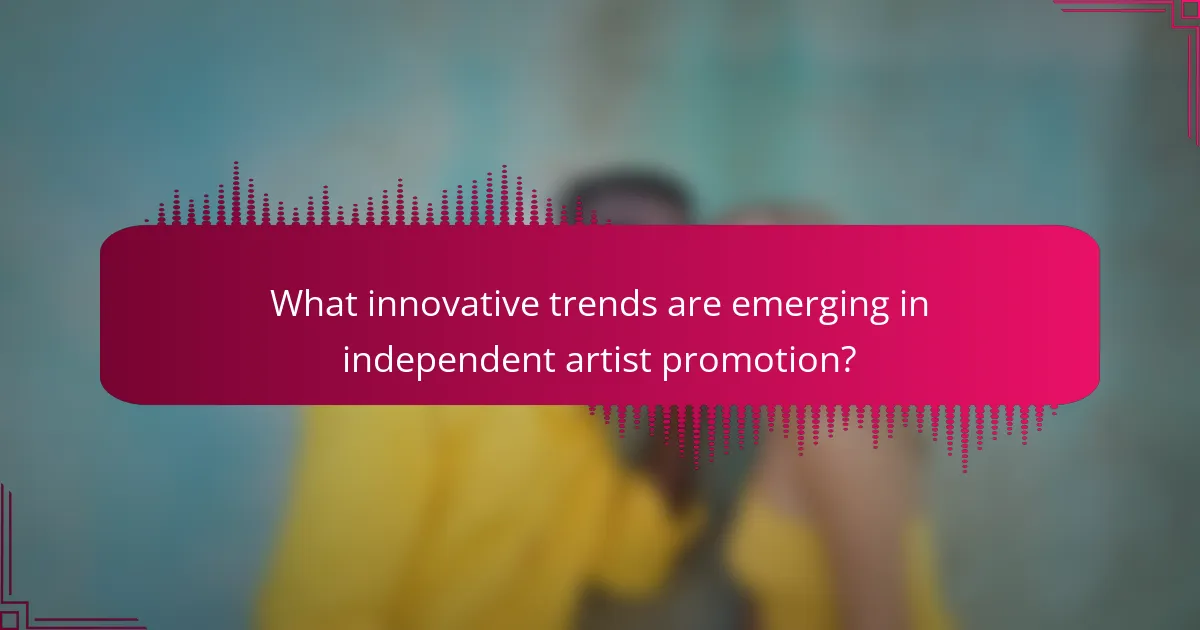
What innovative trends are emerging in independent artist promotion?
Innovative trends in independent artist promotion include leveraging social media platforms, utilizing data analytics for targeted marketing, and engaging in collaborative projects with other artists. These strategies enhance visibility and audience engagement. Emerging technologies like virtual reality experiences and blockchain for music rights management are also gaining traction, offering unique ways to connect with fans.
How does audience engagement shape promotional strategies?
Audience engagement directly influences promotional strategies by guiding content creation and outreach efforts. Artists who actively interact with their audience can tailor their messaging to meet listener preferences, enhancing connection and loyalty. For instance, utilizing social media analytics can reveal audience demographics and interests, allowing artists to craft targeted campaigns. Successful independent artists often leverage fan feedback to refine their promotional tactics, leading to higher engagement rates and increased visibility. Engaging with fans not only fosters community but also drives organic growth through word-of-mouth and shared experiences.
What impact does technology have on the future of artist promotion?
Technology significantly enhances independent artist promotion by providing innovative tools and platforms. Social media enables direct engagement with audiences, while streaming services expand reach. Data analytics helps artists understand listener preferences, optimizing marketing strategies. Emerging technologies like AI create personalized experiences, fostering deeper connections with fans.
Which marketing techniques are gaining popularity among independent artists?
Social media marketing, live streaming, and collaborations are gaining popularity among independent artists. These techniques enhance visibility and engagement with audiences.
Social media platforms like Instagram and TikTok allow artists to showcase their work and connect with fans directly. Live streaming provides real-time interaction, fostering a deeper connection. Collaborations with other artists or brands can expand reach and introduce new audiences.
Utilizing data analytics to track engagement and audience preferences is becoming essential. This approach helps artists tailor their content effectively, optimizing promotional strategies.
As a result, independent artists are leveraging these techniques to build their brand and achieve success in a competitive landscape.
What are the best practices for maintaining an artist’s brand?
To maintain an artist’s brand effectively, consistency, engagement, and authenticity are crucial. Establish a clear visual identity across platforms, interact regularly with your audience, and stay true to your artistic vision.
Utilize social media to showcase your work and connect with fans. Share behind-the-scenes content to foster a personal connection. Collaborate with other artists to expand your reach and diversify your audience.
Regularly update your promotional materials, including press kits and websites, to reflect your current work and achievements. Track your brand’s performance through analytics to refine your strategies.
Finally, invest in professional development through workshops or mentorships to enhance your skills and adapt to industry trends.
What common mistakes should independent artists avoid in promotion?
Independent artists should avoid over-promoting, neglecting audience engagement, and failing to define their brand. Over-promotion can alienate potential fans, while ignoring interaction limits community growth. Clearly defining a brand helps create a recognizable identity, essential for effective promotion. Additionally, not utilizing diverse platforms can restrict reach and visibility.
